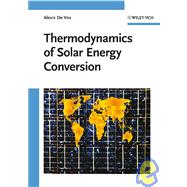
Thermodynamics of Solar Energy Conversion
by De Vos, Alexis-

Receive Free Shipping To The More Store!*
*Marketplace items do not qualify for the free shipping promotion.
Buy New
Rent Textbook
Used Textbook
We're Sorry
Sold Out
eTextbook
We're Sorry
Not Available
How Marketplace Works:
- This item is offered by an independent seller and not shipped from our warehouse
- Item details like edition and cover design may differ from our description; see seller's comments before ordering.
- Sellers much confirm and ship within two business days; otherwise, the order will be cancelled and refunded.
- Marketplace purchases cannot be returned to eCampus.com. Contact the seller directly for inquiries; if no response within two days, contact customer service.
- Additional shipping costs apply to Marketplace purchases. Review shipping costs at checkout.
Summary
Author Biography
Table of Contents
| Radiation | |
| Introduction | |
| Photon Modes | |
| Photon Statistics | |
| Planck's Law | |
| The Stefan-Boltzmann Law | |
| Kirchhoff's Law | |
| Why T4? | |
| Exercises | |
| References | |
| The Solar System | |
| The Sun | |
| The Planets | |
| Starlight | |
| Moonlight | |
| Radiation from "Empty" Space | |
| Internal Heat Sources | |
| Conclusion | |
| Exercises | |
| References | |
| Thermodynamical Engines | |
| Introduction | |
| The Carnot Engine | |
| The Curzon-Ahlborn Engine | |
| Endoreversible Engines | |
| An Example | |
| The Stefan-Boltzmann Engine | |
| Conclusion | |
| An Example | |
| Exercises. | |
| References | |
| Wind Energy Creation | |
| Introduction | |
| Preliminary Model | |
| Final Model | |
| Why 8%? | |
| Tidal Winds and ZonalWinds | |
| Two Examples | |
| Exercises | |
| References | |
| Photothermal Conversion | |
| Introduction | |
| Solar Energy Efficiency | |
| The M8ser Engine | |
| Why 13%? | |
| Concentrators | |
| The M8ser Engine with Concentrator | |
| Selective Black Bodies | |
| The M8ser Engine with Bandgap | |
| Conclusion | |
| An Example | |
| Exercises | |
| References | |
| Photovoltaic Conversion | |
| Introduction | |
| Semiconductors | |
| The Solar Cell | |
| An Example | |
| Exercises | |
| References | |
| Hybrid Conversion | |
| Introduction | |
| Is a Solar Cell Really an Endoreversible Engine? | |
| A Unified Model | |
| Alternative Model | |
| Onsager's Principle | |
| Examples | |
| Exercises | |
| References | |
| Multicolor Conversion | |
| Introduction | |
| PhotothermalMulticolor Converters | |
| Photovoltaic Multicolor Converters | |
| Omnicolor Converters | |
| Two-Terminal Omnicolor Converters | |
| The Bose Engine | |
| Conclusion | |
| Two Examples | |
| Exercises | |
| References | |
| Chemical Reactions | |
| Introduction | |
| Reversible and Irreversible Chemical Engines | |
| The Generalized Endoreversible Engine | |
| Two Alternative Generalized Models | |
| The Endoreversible Chemical Reactor | |
| Conclusion | |
| Exercises | |
| References | |
| Photosynthesis | |
| Introduction | |
| The Photosynthesis Engine | |
| An Example | |
| Exercises | |
| References | |
| Post scriptum | |
| References | |
| Constants | |
| Mathematical Constants | |
| Physical Constants | |
| About the n-Dimensional Sphere | |
| Kepler's Second Law | |
| About a Fourth-Degree Equation | |
| The General Chemical Reaction | |
| List of Symbols | |
| Index | |
| Table of Contents provided by Publisher. All Rights Reserved. |
An electronic version of this book is available through VitalSource.
This book is viewable on PC, Mac, iPhone, iPad, iPod Touch, and most smartphones.
By purchasing, you will be able to view this book online, as well as download it, for the chosen number of days.
Digital License
You are licensing a digital product for a set duration. Durations are set forth in the product description, with "Lifetime" typically meaning five (5) years of online access and permanent download to a supported device. All licenses are non-transferable.
More details can be found here.
A downloadable version of this book is available through the eCampus Reader or compatible Adobe readers.
Applications are available on iOS, Android, PC, Mac, and Windows Mobile platforms.
Please view the compatibility matrix prior to purchase.
